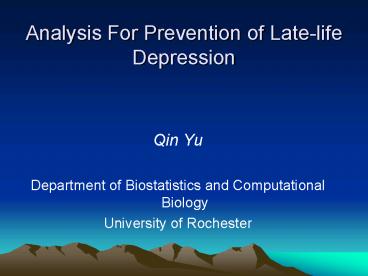Analysis For Prevention of Latelife Depression - PowerPoint PPT Presentation
1 / 22
Title:
Analysis For Prevention of Latelife Depression
Description:
Spousal loss 30.39 27.27. High education 65.32 75.76. Poor or fair health 14.26 30.30 ... DSSI (p. social Support) ( =20) 44.89 60.61 1.69 24.79 56 ... – PowerPoint PPT presentation
Number of Views:21
Avg rating:3.0/5.0
Title: Analysis For Prevention of Latelife Depression
1
Analysis For Prevention of Late-life Depression
- Qin Yu
- Department of Biostatistics and Computational
Biology - University of Rochester
2
Research Context
- Context Late-life depression is associated with
substantial societal costs through its disease
burden and prognosis. - Prevention may be an attractive means to generate
health gains and reduce future costs. - Objectives To target high-risk groups for
depression prevention such that maximum health
gains are achieved. - Design Population-based cohort study over 4
years. - Participants 745 community residents aged 65 to
97 years.
3
Analysis Methods
- Subjects and procedures
- At baseline, 745 people were interviewed aged
from 65 to 97 years. These people were followed
for 4 years, all the predictors are recorded. - Two separate analyses
- limited sample to those without initial major
depression, among 617 people at risk, 33 became
depressed this estimate is equal to 4.4 cases
per 100 person-years - limited sample to those without initial major or
minor depression, among 533 people at risk, 96
became depressed.
4
Statistical Analysis
- The analyses were conducted in several steps.
- First Step
- Calculation of the absolute and relative risk of
becoming a case for subjects with or without
being exposed to a certain risk indicator. - These risk indicators were dichotomized.
5
Statistical Analysis
- Second step
- The importance of risk indicators was
quantified by computing the level of exposure to
a risk factor in the population. - Four risk indicators
- Exposure Rate (ER)
- The incidence rate ratio (IRR)
- Population attributable fraction (AF)
- The number needed to be treated (NNT)
-
6
- Table 1a. Exposure Status (in Percent) in the
Group at Risk and the incident Group limited to
those without initial major depression.
7
(No Transcript)
8
- Table 1b. Exposure Status (in Percent) in the
Group at Risk and the incident Group limited to
those without initial major or minor depression.
9
(No Transcript)
10
Statistical Analysis
- To summarize
- We calculate the ER, IRR, AF, and NNT. Together,
these indicators of impact allow us to select
high-risk groups for which depression prevention
is likely to be associated with the highest
health benefit at the lowest cost.
11
Statistical Analysis
- Third Step
- High-risk group selection process was carried out
by backward-stepping procedures - We selected the smallest set of risk indicators
in which each risk indicator has a unique and
significant contribution to the prediction of
depression.
12
Results
- Parsimonious Model
- Table 3a Parsimonious model for the incident
Group limited to those without initial major
depression.
13
Results
- Parsimonious Model
- Table 3b Parsimonious model for the incident
Group limited to those without initial major or
minor depression.
14
Comments
- The most promising risk indicator was selected
from Table 3a and Table 3b, which was followed by
consecutively selecting and adding risk
indicators in such a way that the values for
potential health benefit (IRR and AF) were kept
as high as possible and the cost (ER and NNT) as
low as possible.
15
Results
- Selecting a smaller set of risk indicators
- Limited sample to those without initial major
depression
16
Results
- Selecting a smaller set of risk indicators
- Limited sample to those without initial major
depression
17
Statistical Analysis
- The fourth step analyses for joint exposures.
- Assessed the potential health benefits when
prevention efforts target people who are exposed
to combination of multiple risk indicators. - Took SSD as the starting point because this risk
indicator is associated with the highest IRR and
AF values and has the lowest NNT and ER.
18
Results
Table 4a Additive effect of Joint Exposures
limited to the sample without initial major
depression.
19
Results
- Table 4b Additive effect of Joint Exposures
limited to the sample without initial major or
minor depression.
20
Comments Quantifying the health gains
- Consider the risk profile in Table 4a and 4b,
e.g. in row 11 of table 4b, the risk of becoming
depressed is a factor 1.39 higher in female with
SSD and has received high education. - If the adverse effect of the joint exposure could
be completely blocked, then the incidence rate in
the population would be reduced by 20.4. - The current incidence rate of 4.4 cases per 100
person-years would then become 4.4 x
(1-20.4)3.5 cases per 100 person-years. In
every 1 million older adults, this would
represent roughly 9,000 prevented cases per year.
21
Comments Quantifying the health gains
- Assuming that an intervention is 30 successful
in avoiding new onsets, then 2,700 onsets will be
avoided. - Assume the excess costs of minor and major
depression as at least 1,045 per person per half
year. Preventing 2,700 onsets would thus result
in a cost saving of at least 2.82 million for
every million elderly people in the population. - If the costs of the intervention do not exceed
1,045 per avoided case, we can still use AF and
NNT value to select interesting preventive
interventions for further cost-effectiveness
research.
22
Comments
- We aimed to answer the question as to whether it
would be possible to target depression prevention
where it generates the best health benefits at
the lowest cost. - This would also guide research efforts toward
more promising research areas in preventive
psychiatry.































